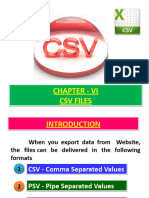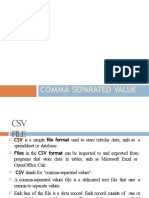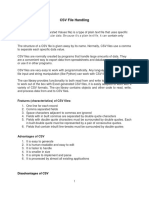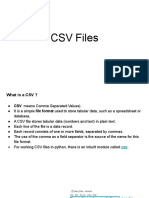0% found this document useful (0 votes)
19 views2 pagesWhat Are CSV Files
CSV (Comma-separated values) files are a simple file format used to store and exchange data in a tabular format, where values are separated by commas. They are widely compatible with various software applications, easy to create and edit, and suitable for applications like spreadsheets and databases. Key features include the use of delimiters, quotes for data storage, and header rows for column identification.
Uploaded by
jinsonjijy50Copyright
© © All Rights Reserved
We take content rights seriously. If you suspect this is your content, claim it here.
Available Formats
Download as DOCX, PDF, TXT or read online on Scribd
0% found this document useful (0 votes)
19 views2 pagesWhat Are CSV Files
CSV (Comma-separated values) files are a simple file format used to store and exchange data in a tabular format, where values are separated by commas. They are widely compatible with various software applications, easy to create and edit, and suitable for applications like spreadsheets and databases. Key features include the use of delimiters, quotes for data storage, and header rows for column identification.
Uploaded by
jinsonjijy50Copyright
© © All Rights Reserved
We take content rights seriously. If you suspect this is your content, claim it here.
Available Formats
Download as DOCX, PDF, TXT or read online on Scribd
/ 2






























































